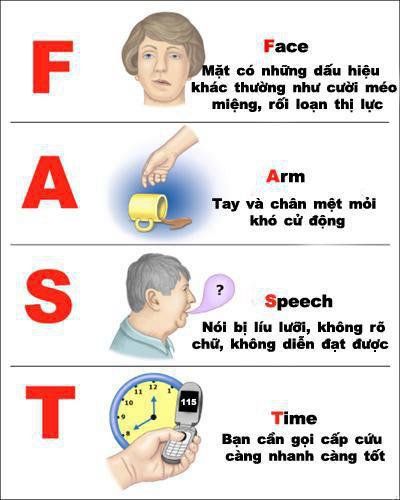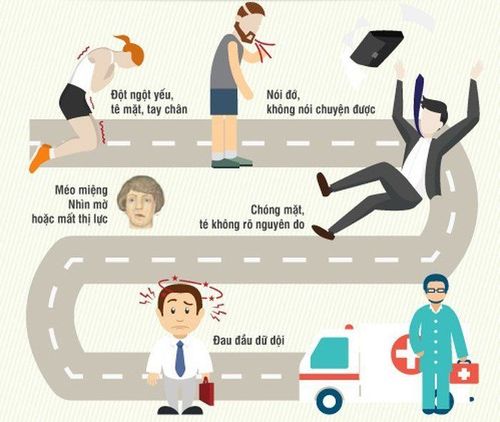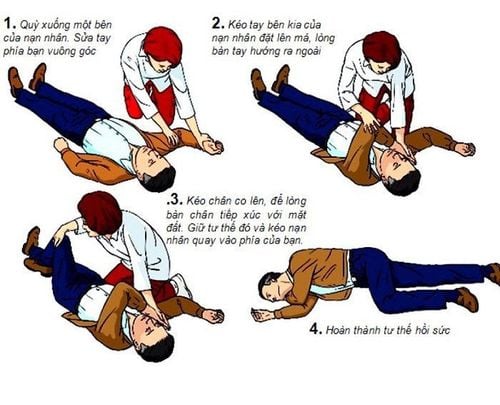This is an automatically translated article.
The article was written by Doctor Nguyen Thai Tri - Head of Emergency Department - Vinmec International Hospital Da Nang.For people who have had a stroke (cerebrovascular accident), in addition to getting first aid early at medical facilities, first aid on the spot is also very important. Proper first aid helps to ensure the safety of the patient while the patient has not received medical assistance from the emergency physician.
1. What is a Stroke (Cerebral Vascular Accident)? Stroke ( Cerebrovascular accident ) is divided into 2 types, depending on the cause of the disease: • Hemorrhagic stroke: Occurs when a blood vessel ruptures, blood escapes the vessel wall and flows into the brain parenchyma, subarachnoid space. , and the ventricles... • Cerebral infarction or cerebral ischemia (cerebral infarction): Occurs when a vessel branch is blocked, in that branch is ischemic and causes necrosis.
Within minutes, without measures to reestablish cerebral circulation to deliver oxygen and other essential nutrients (via the bloodstream) to brain cells, they will begin to die (average 1, 9 million neurons die/min) and continue for several hours.
A stroke is an emergency that needs to be treated as quickly as possible – the earlier it is treated, the less brain damage is done. For patients with a thrombotic stroke, treatment must be initiated within the first hour.
>> See more: Nattou Ichou health food by Pharmacist, Master Pham Thi Kim Dung - Pharmacist Mixing drugs - Faculty of Pharmacy - Vinmec Times City International Hospital
2. Two Rules for Early Stroke Recognition A stroke can be detected early with the FAST or BEFAST Rule:


Paralysis of hemiplegia or extremities makes the patient difficult to move Cognitive disorders: forgetfulness, confusion, dementia Language disorders: difficulty expressing thoughts into words, slurred speech, slurred speech, changes in intonation and intonation Visual disturbances: blurred vision on one or both sides. In more severe cases, the patient may be partially or completely blind. Round muscle disorders: Difficulty urinating, urinary retention, urinary incontinence. The dangerous complications after stroke all seriously affect the health, spirit and financial costs for the patient, family and society. >>> Stroke - Dangerous complications of cerebral vascular malformation
4. First aid for stroke patients SPECIAL NOTE: Call for help and immediately call an ambulance. While waiting for support, it is necessary to closely monitor to promptly detect abnormal changes in the patient's condition. If there are any signs of impaired consciousness, or the patient shows signs of vomiting, the patient should be placed in a safe side-lying position.
The safe side position (also known as the emergency resuscitation position) is the position to protect the patient's airway, also the best choice in ensuring patient safety. In a comatose patient, when lying on their back, the tongue will drop down to the throat, obstructing and blocking the airway. If the patient vomits while lying on his back and the consciousness is not fully awake, it is easy to inhale the vomit into the lungs, causing airway obstruction or respiratory failure, which is very dangerous. Therefore, it is necessary to place the patient on his side to allow the vomitus to escape easily.
>>> Instructions for stroke first aid at home

If the patient is awake:
Support the patient to lie in the most comfortable position and monitor the patient's reaction. Immediately call an ambulance and take the patient to the hospital. When performing on-site stroke first aid, absolutely do not let the patient use drugs or eat anything, do not use a needle to prick the patient's fingers or feet, and do not shave.
Please dial HOTLINE for more information or register for an appointment HERE. Download MyVinmec app to make appointments faster and to manage your bookings easily.














